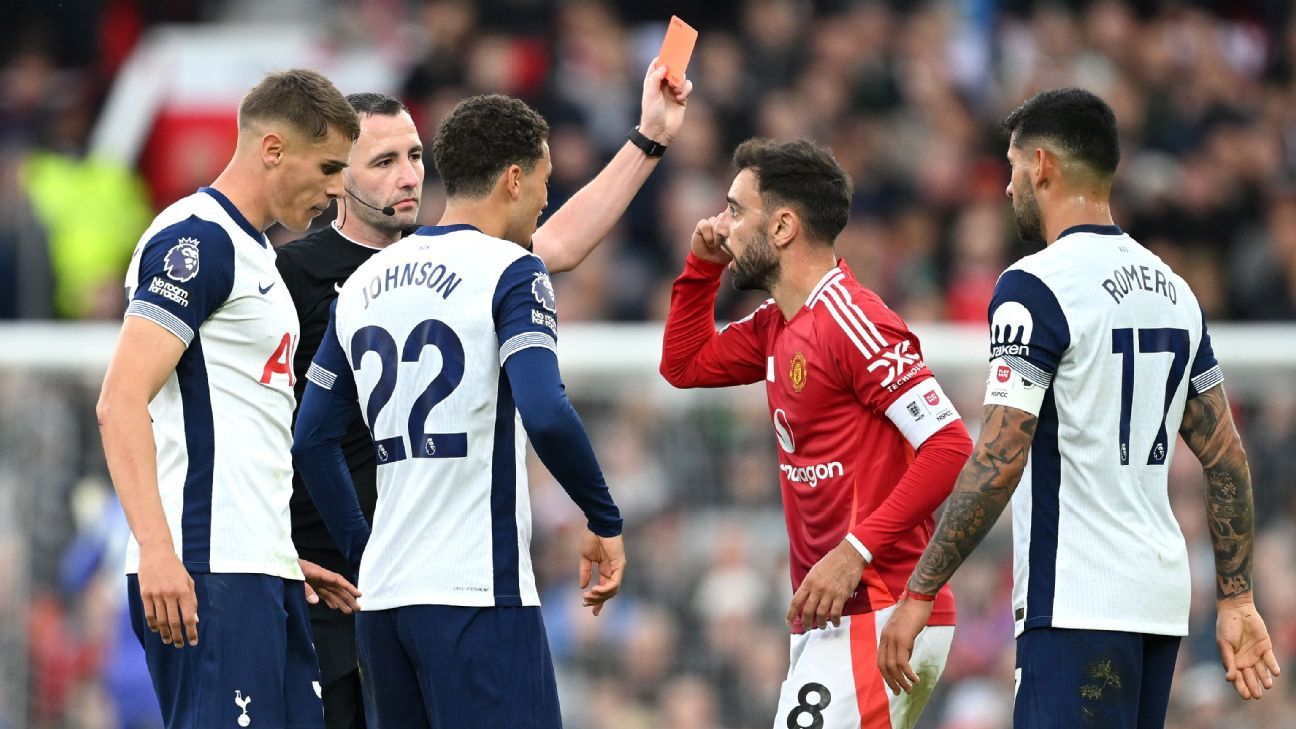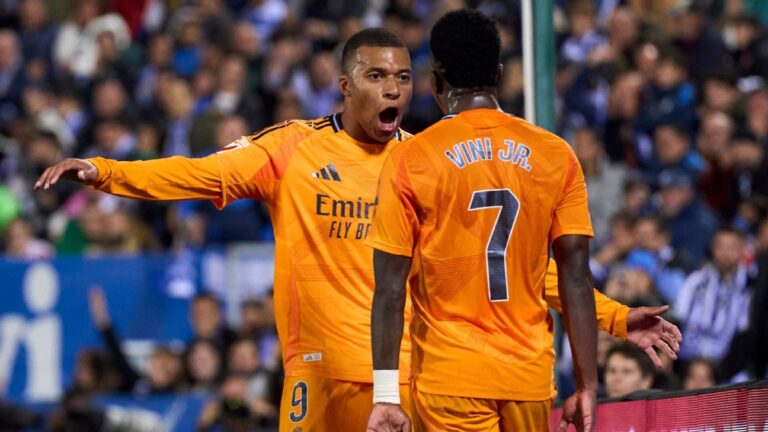Video Assistant Referee causes controversy every week in the Premier League, but how are decisions made, and are they correct?
After each weekend we take a look at the major incidents, to examine and explain the process both in terms of VAR protocol and the Laws of the Game.
In this week’s VAR review: Should Bruno Fernandes‘ red card against Tottenham Hotspur have been rescinded? And should Newcastle United‘s penalty against Manchester City have been overturned?
Bruno Fernandes is sent off by referee Chris Kavanagh. Michael Regan/Getty Images
Possible red card overturn: Fernandes’ challenge on Maddison
What happened: James Maddison was on the ball in the 42nd minute and looked to turn Bruno Fernandes. Maddison got past the Manchester United player, who then stuck out a leg to bring him down. Referee Chris Kavanagh produced a red card for serious foul play, which was checked by the VAR, Peter Bankes. (watch here)
VAR decision: Red card stands.
Bruno Fernandes’ challenge looked worse in real time to the on-field officials. BBC
VAR review: Fernandes slipped as he first looked to challenge Maddison, but this isn’t really valid in assessing the tackle. The slip might have caused Fernandes to adjust the way he was making the challenge, but it wasn’t purely a slip into the Tottenham player — the boot was raised after the slip a desperate lunging action, not a direct result of it.
Editor’s Picks
2 Related
However, that doesn’t change the fact that this should have been a VAR review to downgrade red to yellow.
For Kavanagh and especially his assistant, who was flagging furiously as Maddison went down, you can see why they went for a red card. Fernandes went in high at around shin height, had no prospect of playing the ball and at first looked like it was cynical with studs into the opponent.
Yet once different camera angles were shown, it became clear that Fernandes had not led with, or made any contact with his studs, and there was low force. It was a glancing blow with the outside of his boot.
Bruno Fernandes caught James Maddison with the outside of his boot. Michael Regan/Getty Images
The high bar for intervention can cause the VAR to find ways to support the on-field decision, when there is clear evidence of a mistake. This feels like one of those occasions. The VAR has stuck with the red card due to the general nature of the lunge rather than the resulting contact.
Missed VAR interventions was the Premier League’s big issue last season with 26 errors, but so far the Key Match Incidents Panel hasn’t logged a single mistake. That will surely change with the Fernandes red, which should have been changed.
Earlier this season, Manchester United were the beneficiaries when Southampton‘s Jack Stephens was sent off for a knee-high tackle on Alejandro Garnacho. You can argue there are similarities to back up the Fernandes red, as there was minimal contact, but there was a clear lead with the studs into the opponent, and much higher too.
Jack Stephens made contact on Alejandro Garnacho’s knee with his studs leading. BBC
United will surely appeal Fernandes’ suspension and have a high chance of success, though it really does depend which three ex-players you get on the disciplinary commission.
There was probably a greater argument for a red card for Manchester City’s Mateo Kovacic for his lunging tackle on Newcastle’s Sandro Tonali with no prospect of playing the ball, or Wolverhampton Wanderers‘ Carlos Forbs for raking down the Achilles of Andrew Robertson. Both of these challenges were given as yellow cards on the field, but there was no likelihood of being upgraded with how VAR works in England.
Red cards for serious foul play have always been pretty inconsistent in the Premier League. With referees told to allow a higher level of physicality than you’d get in the other top European leagues, there are plenty of examples of “orange” challenges, which might be a red in Italy or Spain but result in a yellow in the English game.
Mateo Kovacic was booked for a tackle on Newcastle’s Sandro Tonali. BBC
That’s not to say the Premier League does it better, as there’s a clear argument that a lower threshold for serious foul play is better for player welfare. And this weekend was no different on that front.
From a collection of late challenges, with no prospect of playing the ball, Fernandes was the only player to see red.
Possible penalty: Handball by Romero
What happened: Marcus Rashford delivered a cross into the area in the 60th minute, the ball came off Garnacho and then hit the arm of Cristian Romero. United’s players appealed for a penalty, which were waved away by the referee.
VAR decision: No penalty.
Cristian Romero had his arm close to his chest. BBC
VAR review: Romero had his arm close to his side and he was trying to move it away when it was hit by the ball.
Possible penalty overturn / red card: Ederson challenge on Gordon
What happened: Anthony Gordon broke through the centre in the 56th minute and went to ground under a challenge from Manchester City goalkeeper Ederson. Referee Jarred Gillett pointed to the spot and produced the yellow card. Was there a foul? And if so, should Ederson have been sent off?
VAR decision: Penalty stands, scored by Gordon. No red card.
VAR review: There was contact from Ederson’s glove on the left boot of Gordon, so the VAR, Stuart Attwell, wasn’t going to get involved to reverse the spot kick. And as Ederson was making an attempt to play the ball before Gordon nudged it past him, it can only be a yellow card for denying an obvious goal-scoring opportunity inside the area.
An attacker has no responsibility to avoid contact from an opponent. While a decision such as this may seem a little soft, an attacker has every right to use the momentum of the challenge coming directly into him. It’s different from initiating contact when a player moves a foot into an opponent to force the impression of a foul.
Ederson catches Anthony Gordon’s left foot with his glove. Matt McNulty/Getty Images
Possible penalty: Walker challenge on Joelinton
What happened: From the resulting free kick for the foul on Tonali, Newcastle pumped a long ball toward the Manchester City box, and it was flicked on to put Joelinton through. The Brazilian was bundled over by Kyle Walker, but referee Gillett ignored the penalty claims. (watch here)
VAR decision: No penalty.
Was Joelinton bundled over in the box by Kyle Walker? BBC
VAR review: It’s a strange challenge by Walker, who puts his leg across Joelinton to prevent him getting to the ball, rather than attempt to play it.
Walker is very fortunate because if the referee gives this as a penalty then there’s no chance it gets overturned. It’s the kind of situation that the KMI Panel hasn’t tended to view as a mistake.
Possible foul before a goal: Saliba on Vardy
What happened: Leicester City were furious about the lead up to Arsenal‘s opening goal in the 20th minute, with Jamie Vardy claiming he was pulled back by William Saliba in the centre circle. Referee Sam Barrott didn’t give a foul, and Arsenal scored 14 seconds later through Gabriel Martinelli. (watch here)
VAR decision: Goal stands.
William Saliba has his hand on the shoulder of Jamie Vardy. BBC
VAR review: Arsenal had five touches of the ball, and Leicester were set throughout the move.
Saliba had his arm on Vardy’s shoulder, and you can argue the case for a foul on the field but there wasn’t enough in it for a VAR intervention from Paul Tierney.
Possible onside: Havertz when scoring
What happened: Kai Havertz thought he had added a fourth goal in the ninth minute of stoppage time, but the offside flag went up. A quick VAR check showed the on-field officials hadn’t got it right. (watch here)
VAR decision: Goal.
James Justin plays the ball to Kai Havertz. Premier League
VAR review: Barrott and his assistant thought the ball had touched Raheem Sterling before it ran to Havertz. This didn’t have to be a pass from Sterling, as any touch would have created the offside phase against Havertz. It was clear though that Leicester defender James Justin had prodded the ball to Havertz, so the goal was awarded.
Possible offside: Schade on Mbeumo goal
What happened: Brentford took the lead in the first minute through Bryan Mbeumo, but there was an offside check in the buildup against Kevin Schade.
VAR decision: Goal stands.
VAR review: Another example of a goal that was allowed, but once semiautomated offside comes in (it’s now been delayed until next year) would likely be disallowed.
When a player’s position is within the tolerance level (when the two lines are touching) using the current technology, he will be given onside even if marginally off. The “benefit of the doubt” exists due to inaccuracies in the system.
When the tolerance level has been used to make the decision, only a single green line is drawn to the last defender. In this case, the vertical line from Schade’s shoulder would drop down within the green line.
Possible penalty overturn: Rutter foul on Sancho
What happened: Chelsea were awarded a penalty in the 27th minute when Jadon Sancho broke into the area and was sandwiched between Georginio Rutter and Carlos Baleba. Referee Peter Bankes pointed to the spot for a foul by Rutter.
VAR decision: Penalty stands, scored by Cole Palmer.
VAR review: It looks soft on initial viewings, but Rutter places his right leg into Sancho, which causes the forward to go down. That said, it feels unlikely that the VAR would have advised a penalty if it hadn’t been given.
Georginio Rutter and Carlos Baleba manage to bundle over Jadon Sancho. BBC
Possible penalty: Tarkowski challenge on Mateta
What happened: Jean-Philippe Mateta ran onto a long ball in the 38th minute and turned back inside Jarrad Branthwaite. James Tarkowski tracked back to make the challenge and won the ball, but also make a lot of contact on the Crystal Palace striker. Referee Andy Madley said no penalty and play continued.
VAR decision: No penalty.
James Tarkowski wins the ball before clattering into Jean-Philippe Mateta. BBC
VAR review: While Tarkowski clearly won the ball, that doesn’t mean this can’t be a penalty if the referee or the VAR, Graham Scott, deem the challenge to be reckless.
It’s a borderline call, and the VAR must have seriously considered this for a pitchside review. But with the high bar in the Premier League, we shouldn’t be surprised it stayed with the referee’s call.
Possible penalty: Challenge by Murillo on Pereira
What happened: Andreas Pereira was preparing to meet a ball played into the area in the 47th minute and went down under pressure from Murillo. Referee Josh Smith allowed play to continue but he was sent to the monitor by the VAR, John Brooks, to award a spot kick.
VAR decision: Penalty, scored by Raúl Jiménez.
VAR review: When is a foul enough for a VAR penalty? It’s hard to explain sometimes, as decisions within one game can seem inconsistent.
Murillo prevents Pereira from being able to play the ball by standing on the back of his Achilles, and putting his hand on the back of the Fulham player. Yet we see other challenges which look far more deliberate which don’t lead to a VAR review.
The VAR decided the contact on the heel of Andreas Pereira was sufficient for a penalty. Premier League
Possible penalty: Challenge by Bassey on Elanga
What happened: In the 63rd minute, Anthony Elanga looked to get on the ball ahead of Calvin Bassey inside the area, but the Nottingham Forest player appeared to have his foot hooked by the defender. The referee waved play on, and it was again looked at by the VAR.
VAR decision: No penalty.
VAR review: And this is where the questions of consistency within one game come in. Was there really a huge difference between this and the penalty given to Fulham, which proved to be the game winner? You can say that in both cases the contact from the defending player prevented the opponent from being able to play the ball, yet only one was a spot kick on VAR review.
Anthony Elanga appears to have his foot hooked by Calvin Bassey. MI News/NurPhoto via Getty Images
Possible penalty overturn: Semedo foul on Jota
What happened: Referee Anthony Taylor awarded a penalty to Liverpool in the 58th minute. Trent Alexander-Arnold delivered from the right and Diogo Jota looked to meet it, but he appeared to be dragged down by Nélson Semedo.
VAR decision: Penalty stands, scored by Mohamed Salah.
VAR review: Grappling inside the box always comes across as being inconsistently applied, but when a defender has an arm around the neck of an opponent, and there’s no mutual holding, it’s likely to be a penalty.
It wouldn’t be considered a red card for denying an obvious goal-scoring opportunity against Semedo, because there is enough doubt over the Liverpool player being able to win the ball and have a good chance to score.
Diogo Jota is dragged down by Nélson Semedo. BBC
Some factual parts of this article include information provided by the Premier League and PGMOL.







